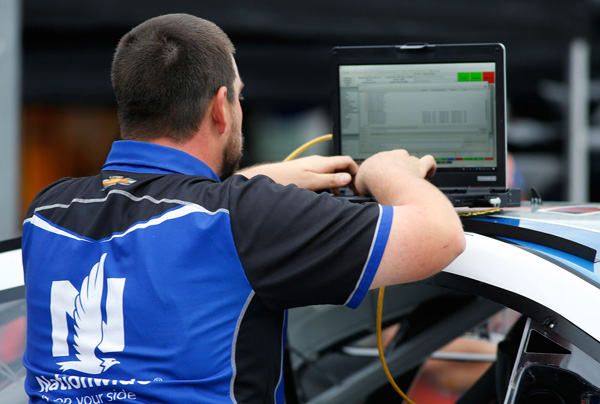NASCAR fans could soon have more data showing what makes their favorite cars, and drivers, tick.
Industry stakeholders are working to make the sport less secretive, with drivers’ vital signs and additional pit stop data two elements under consideration to provide deeper engagement with fans. The thought is that sharing more data could excite diehard fans and entice casual or non-fans.
Such sharing is no small task, however, considering the amount of money teams spend each year to gain an edge on the track.
“We continue to look for new ways to make NASCAR a more interactive experience for our fans,” said Steve O’Donnell, NASCAR’s executive vice president and chief racing development officer. “Visor cams, PRO system officiating on pit road, the Air Titan program and race formats are just a few recent innovations that are collaborative in nature and designed specifically to benefit our fans. We continue to work with each industry stakeholder to develop future innovations and technology solutions to enhance the fan experience and continue leading the motorsports industry.”
 |
Sharing data generated from drivers’ wearable technology and from pit road are areas under study.
GETTY IMAGES |
Among the ideas being considered is drivers sharing data generated from wearables they have on during the race. That data could offset the stereotype that drivers don’t face the same rigors as other athletes.
NASCAR permitted drivers to use approved wearables starting in 2016. In July, driver Jamie McMurray tweeted a comparison of his wearable data after a bike competition and data after a NASCAR race, showing the similarities and in some cases even more extreme conditions during the race. The post drew nearly 1,400 retweets and more than 3,300 likes on Twitter.
Fox Sports NASCAR analyst Larry McReynolds said his network is interested in showing fans such information on screen during races, and is working with NASCAR and teams toward that end. McReynolds, who reflected on how long it took NASCAR to approve the visor cam that has now started to become commonplace, said he could see Fox comparing a driver’s heart rate before the race versus more stressful situations later in the race. First, team concerns and even governmental laws must be worked through. Drivers own their own wearable data.
“We want to always keep working to get more information out there,” McReynolds said, “but we don’t want to get too deep because if you get too deep, that can turn people off as well.”
Another idea is sharing more data from pit road with viewers, potentially by bundling the information into a package that fans could monitor during races. Crew members and the cars themselves generate scores of data during pit stops; crews change a driver’s tires, tweak the car’s setup and fill it with gas in less than 15 seconds, while NASCAR keeps track of how fast cars are going on pit road and breaks it down by segments in order to catch drivers exceeding pit road’s speed limit. NASCAR owns the data related to pit road timing and scoring, while teams own data and video related to their specific cars’ pit stops.
NASCAR isn’t alone in pushing for sharing more data. The new owners of Formula One want to make more data public in that racing series as well. F1 CEO Chase Carey has spoken repeatedly about secrecy in the sport being an inhibitor to growth — one which he intends to change.
Carey was quoted in The Financial Times in June as saying team executives who don’t want to share the intricacies of their car setups “look at the world they compete in and do not remember why we do this thing … which is to create the best experience.”
McReynolds, a former top crew chief, said he still deals with current crew chiefs who get upset when he shares a trend going on in teams’ car setups. He said that earlier this season Hendrick Motorsports’ Chad Knaus, crew chief for seven-time champion Jimmie Johnson, was puzzled as to why McReynolds shared details about how teams have a secondary fuel reserve they can switch to if they’re running out of gas.
“He unloaded on me — he said, ‘Why are you showing that stuff?’” McReynolds recalled. “I said, ‘Chad, it’s part of our sport. … If I don’t show the fans what you guys mean when you tell your driver to throw the switch, I’m not doing our fans justice.’”




